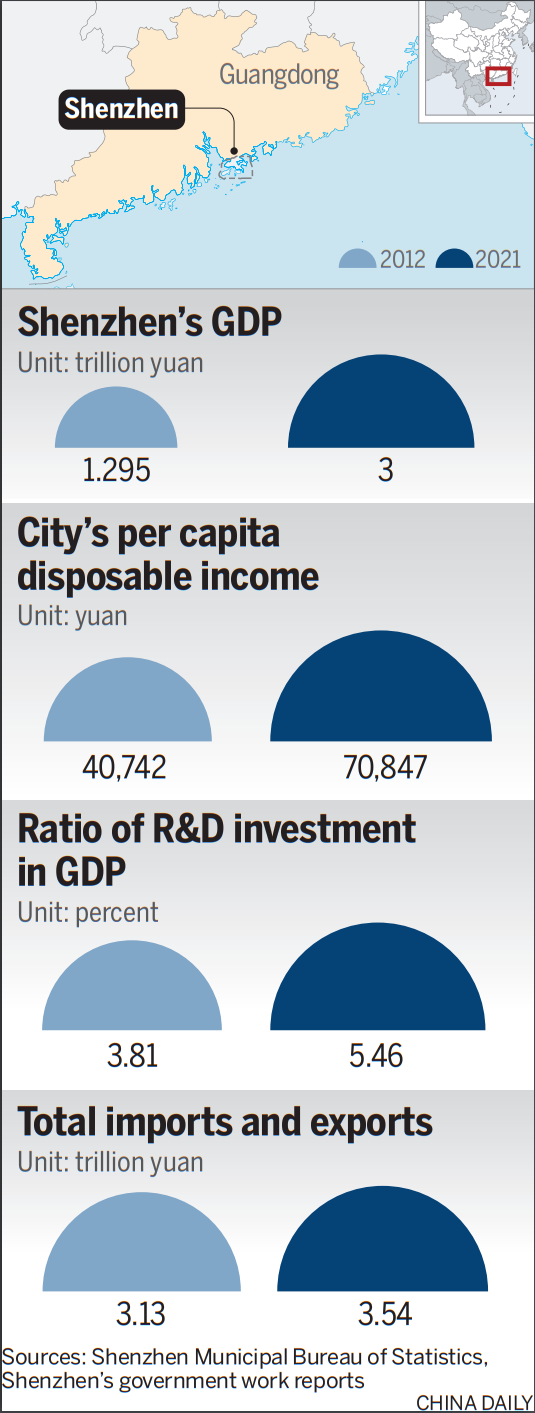Innovation continues to fuel Shenzhen's growth


'Primary driving force'
During a visit to Shenzhen in October 2020 to celebrate the 40th anniversary of the founding of Shenzhen Special Economic Zone, President Xi identified the valuable experience of Shenzhen, including "taking innovation as the primary driving force".
Xi also stressed that Shenzhen should modernize its urban governance system and capacity through innovation, and solve problems in urban governance with a rule-of-law mindset and methods.
Innovation has been driving up Shenzhen's economic growth, improving the business environment and benefiting people's lives in various ways. In the past decade, Shenzhen's gross domestic product has surged from 1.295 trillion yuan ($192 billion) in 2012 to 3 trillion yuan in 2021.
The southern coastal city, known for its scientific and technological innovation, has been increasing investment in research and development. In 2021, the total R&D investment accounted for 5.46 percent of the city's GDP, ranking among the top in China, while the proportion is about 3.81 percent in 2012, according to government statistics.
According to data from the Shenzhen Administration for Market Regulation, the city ranks at the top nationally in entrepreneurship density, with the total number of market entities reaching about 3.8 million in 2021, the city's permanent population standing at 17.68 million, and more than one in 10 people having their own business.

However, technological innovation has never been smooth sailing. The first obstacle for Zhou Jian's startup was to make the servo actuator-a core component used to induce or control motion in mechanical systems that is highly technological and expensive and provided by just a handful of foreign producers.
It took his team about five years to independently develop the high-performance servo actuators and algorithms needed for movement control, computer vision, autonomous navigation and positioning of the company's robotic devices.
During the darkest time, he recalled that he had to sell his car and apartment, and move the startup to an industrial park far from the downtown area to save on rent.
Shenzhen began to give priority in 2013 to five "future industries", including artificial intelligence robots, wearable devices and other smart equipment. A detailed five-year plan for bolstering these fields through technological and capital support was released the following year.
A number of incubators have been set up, with preferential policies and rental discounts to attract and cultivate innovative enterprises, especially those in emerging industries.
Zhou had applied to locate to one of the facilities in Nanshan iPark but failed to meet the requirement for the total amount of taxes paid.
"But I was not refused directly," he said. "On the contrary, the managers of Nanshan iPark reached out to me to learn more about our production," and eventually UBTech was approved to move in.
He said the surging number of entrepreneurs in Shenzhen also boosted his confidence in pursuing his dream.
"Shenzhen is one of the cities with the best combination of capital and technology in the country, and both the government and investment platforms pay great attention to scientific and technological innovation enterprises," he said.
The city has established about 20 advanced manufacturing industrial parks in order to augment industrial chains and clusters. In 2021, the added value of strategic emerging industries reached 1.12 trillion yuan, accounting for 38.6 percent of Shenzhen's GDP.
Shenzhen's favorable investment environment has attracted many startups and talent from the Hong Kong and Macao special administrative regions. For instance, the Qianhai Shenzhen-Hong Kong Youth Innovation and Entrepreneur Hub had welcomed more than 150 Hong Kong startups by the end of 2021.
In addition, Shenzhen and Hong Kong are jointly establishing the Hong Kong-Shenzhen Innovation and Technology Park in the Lok Ma Chau Loop, a major platform of cooperation in the Guangdong-Hong Kong-Macao Greater Bay Area.
So far, more than 100 innovative projects have been set up in the park, and Hong Kong University of Science and Technology has set up an incubator, Blue Bay, to help commercialize the school's scientific research results.
Besides technology, the city has made strides in institutional innovation with a series of first-in-China regulations unveiled over the past 10 years, including those regarding individual bankruptcy, data management and a punitive compensation system for intellectual property infringement.























